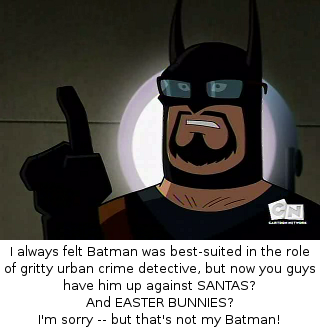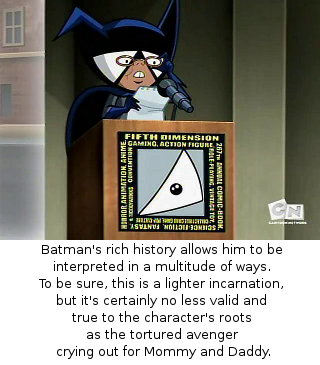Originally posted on Brontoforumus, 2010-03-24 and 28; presented here with some edits.
A few months back, I was in my local independent bookseller, and I ran across Jack Cole and Plastic Man: Forms Stretched to Their Limits. I didn't even notice Spiegelman's name on the cover, I just flipped through the book and thought hey, this is pretty neat. And then my girlfriend got it for me for Christmas.
I started it today, and...wow.
Here's the thing: I've never actually read a Plastic Man comic before. I'm aware of him, I'm aware of Cole's work, but...I had no idea what I was missing out on.
It's just absolutely phenomenal stuff. The double-meaning in the book's title is apt: Plastic Man is like nothing I've ever seen before. It doesn't so much defy rules as live in a world where they haven't been invented yet. It freewheels between absurd whimsy and slapstick and completely shocking violence -- in one story, the villain, trying to escape, trips and lands with his head in a bear trap and dies. (It's page 12 in the link above.) There is absolutely nothing to foreshadow this; there is just a fucking bear trap all of a sudden. It's a real straight-up anything-can-happen book -- the closest analog I can think of is Tex Avery. (Spiegelman says it's like "Tex Avery on cocaine".)
Of course, Spiegelman's name is on the cover because a good big chunk of the book is a biography he's written -- and Cole is a fascinating character, right from the start. Early on, there's a story of how, at the age of 17, he biked from Pennsylvania to LA -- and there's a photocopy of his first published work, a piece he wrote about the journey that was published in Boys' Life.
I've read some very good comics histories over the past couple years, but none that used the artist's actual work so extensively. The Ten-Cent Plague, in particular, is a great book whose greatest weakness is its need to describe covers because it can't just print them (not sure whether that was due to rights issues or cost of printing, but at any rate there are many cases where it tells when it should show). Not only does Spiegelman use extensive excerpts of Cole's work, he discusses them with an artist's eye -- Cole's talent for layouts, the way Plastic Man draws your eye to create a sense of motion -- there are even diagrams.
And speaking of layouts, there's a reason Chip Kidd's name is on the cover too. He's the graphic designer who put it all together, Spiegelman's words and Cole's pictures. The whole thing is composed like a giant magazine article -- which it actually is, as it began life in The New Yorker. (Those of you familiar with Spiegelman will know that he is a major contributor to the magazine, and is married to Francoise Mouly, the art editor and a supreme talent herself.) The book is absolutely flooded with incidental Cole work, sometimes just a few panels on a page and sometimes a complete, uncut story. (Interestingly -- well, if you're interested in things like paper stock, which you actually most likely are not --, the pages that reprint stories in longform are newsprint, while the rest of the book is glossy. Those of you familiar with reprints of old comics have most likely observed that the old 4-color printing process looks much better on the newsprint it's intended for than on glossy paper. Scott McCloud discusses this a good bit in Understanding Comics.)
I've never seen a book quite like this, and I've never read a comic quite like Plastic Man. It's a deft combination -- Spiegelman makes for a great biographer and a great art teacher, and is equally masterful at knowing when to step the hell back and let the man's work speak for itself. And Kidd puts the whole thing together, creating an eye-catching presentation that's easy to read, or, if you prefer, just glance at. (I prefer to read everything, even the incidental stuff -- and even on the thumbnails, the text is big enough to read.)
The book also reprints Cole's infamous Murder, Morphine and Me in its entirety. I'd never read the story before (though I'd seen the infamous "woman about to get a syringe in the eye" panel that made it Exhibit A in the 1950's Senate hearings on comics), and it's an important piece of history, as well as a very neat contrast to the whimsy of the Plastic Man stories. It's got an afterschool-special quality to its message, and a predictable twist ending, but it's also got sympathetic characters, a breakneck pace, expressive art, and content that's graphic not just for violence's sake but to truly move the audience. It represents everything that thrilled young audiences of the time, and scared the old guard. It's just as powerful a representation of the no-rules nature of groundbreaking Golden Age comics as Plastic Man, with the same artist but an entirely different tone and genre.
This book makes me want to go out and buy a bunch of Jack Cole stuff. In the span of an hour he has become one of my favorite artists, and I don't know how I managed to miss out all these years.
And this book is the best casual introduction I can see, as sadly there is no set of cheap Chronicles paperbacks for Plas -- just $50 hardback Archives. I'm seriously considering saving up, though -- I want to see more.
Fortunately, there are also a lot of old Plastic Man comics available at Digital Comic Museum, which collects public domain comics. You can find Plastic Man in both his self-titled book and in Police Comics.

